Before the Anaheim Ducks lost to the Nashville Predators in the first round of the 2016 NHL playoffs, they had a strong enough regular season to win the Pacific Division title. The Ducks finished with a 46-25-11 record and 103 points. The Ducks might have been aided by playing in a weaker division, highlighted by a 19-6-4 in-division record, but they did just fine outside of the Pacific. They went 17-11-4 in the East overall: going 9-6-1 in the Atlantic and 8-5-3 in the Metropolitan. In the West, they went 29-14-7 overall with a 10-8-3 record versus the Central to go along with their Pacific division record. While those numbers are not overwhelmingly positive, they are not detrimental either. The Ducks took care of a top-heavy division and did well enough outside of it. For some context on the record, the Central Division, Western Conference regular season champion Dallas Stars went 19-7-3 in the Central. The top teams always do well in their own division.
While those numbers are not overwhelmingly positive, they are not detrimental either. The Ducks took care of a top-heavy division and did well enough outside of it. For some context on the record, the Central Division, Western Conference regular season champion Dallas Stars went 19-7-3 in the Central. The top teams always do well in their own division.
I mention this because the last four seasons the Anaheim Ducks have been considered a Stanley Cup contender. With Bruce Boudreau leaving such a strong and talented team, will he be able to replicate his past success with a seemingly worse team in Minnesota?
The Wild Last Year
The Minnesota Wild had their most disappointing season in team history. Never had the expectations been higher. Never had a team failed to meet expectations so spectacularly. The Wild limped into the post-season with a 38-33-11 record and 87 points. No player on the team reached 30 goals, and only one player surpassed 60 points. There seems to be nothing outstanding about this team. Especially when compared to a team such as the Ducks.
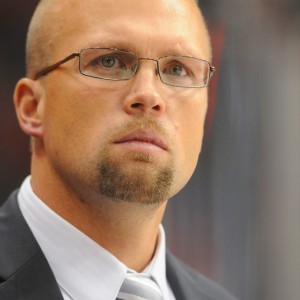
However, the Wild are far more difficult to pin down than simply being an average team. When the Wild decided to adhere to Mike Yeo’s system they were a great team. When they did their own things, they were atrocious. This can be traced to how well they possessed the puck. Yeo received a lot of criticism for being too defensive. What gets forgotten is his emphasis on controlling the puck. Through the first 10 games of last year, the Wild went 7-3 with a 51.3 CF% and High Danger Scoring Chances For (HDSCF%) of 51.7%. Over the next ten games, the Wild went 4-6 with a 46.6%-CF% and a 39.4-HDSCF%. These kinds of dips were trademarks of the Wild during the Yeo era. One could refer to this as the Parise/Suter era as well. As the year progressed, the CF% rarely eclipsed 50% for a long period of time and consisting winning was hard to come by. The Wild finished the season with a dismal 47.59-CF% and an okay 50.15-xGF%. The two numbers together tell the tale of a team that in spite of never really having the puck, they still generated good chances. However, when you compare the Wild numbers to the Ducks underlying numbers of 52.76-CF% and a 52.65-xGF% from last year, it is hard to make the argument that the Wild roster is close to/or equal to the Ducks. So let’s take a closer look.
2015-16 Ducks vs. 2016-17 Wild Roster
In order to get a sense of how the roster Boudreau left compares to the roster he’s inheriting, I compiled the numbers of the current Wild roster and Anaheim’s roster last year.
In order to compare, I used twenty different measurements and determined what team was “better” at said measurement. The measurements are as follows: Corsi For% (CF%), expected Goals for% (xGF%), Points per 60 minutes (P/60), [all of which were adjusted for venue and score, are 5on5 measurements, and are separated by forward and defensemen], total goals (by F and D), total assists (by F and D), total points (by F and D), Avg. Sv% (5on5), Top Sv% (5on5), and finally team CF% and xGF%. I understand that a lot more goes into a team, but these numbers paint a fairly accurate picture of what each roster produced.
Forwards
Average of all forwards
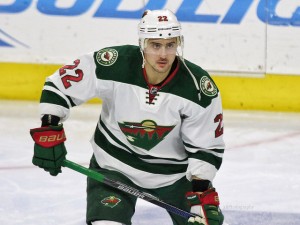
CF%: MN-47.05, ANA-52.82
xGF%: MN-47.85, ANA-52.55
P/60- MN-1.38, ANA-1.34
The big surprise here is that despite their poor possession and scoring chance numbers, Wild forwards were able to produce points per 60 minutes of playing time at a better rate than the Ducks forwards. In fact, the Wild had two players with a P/60 over 2.0 (Haula and Nino); whereas, the Ducks had none. As a group of forwards, the Ducks players controlled the puck and play more than the Wild did. However, the Wild forwards were still able to produce. The question then becomes, how could a group of forwards who had the puck more and created better chances not produce better than a group that wasn’t? Perhaps the Wild’s group of forwards are better than many fans think. Or did the Ducks catastrophic start to the season in goal scoring had something to do with the low totals?
The answer is likely two-fold. The Wild’s group of forwards are better than many think, and the Ducks catastrophic start to the season in goal scoring had something to do with their totals.
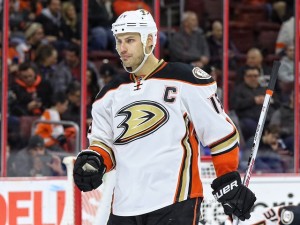
Total Goals: MN-183, ANA- 185
Total Assists: MN-273, ANA-258
Individual Leaders
Goals: MN-25 Zach Parise, ANA-34 Corey Perry
Assists: MN-41 Mikko Koivu, ANA- 53 Ryan Getzlaf
Points: MN-61 Mikko Koivu, ANA-68 Ryan Getzlaf
While the Ducks boasted players with bigger individual numbers, the Wild were able to keep pace with a more balanced attack. The Ducks came out on top in all categories but two when comparing forwards. Bruce Boudreau will be leaving a team with a group of highly skilled forwards that relied heavily on Perry and Getzlaf, to a highly skilled group of forwards that relied heavily on Parise and Koivu. The difference? Perry and Getzlaf are better than Parise and Koiv. However, the Wild appear to have more players who can produce when given more minutes than the Ducks do. Either way, Boudreau has shown he can take a team who doesn’t score many goals and get them to win a lot of games.
ADVANTAGE- DUCKS 6-2
Defensemen
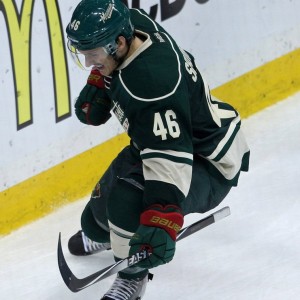
Average of all defensemen
CF%: MN-46.53, ANA-52.16
xGF%: MN-48.31, ANA-52.32
P/60- MN-.665, ANA-.516
The Ducks have three highly touted young defensemen in Cam Fowler, Sami Vatanen, and Hampus Lindholm. With all the attention focused on Fowler, you’d think he’d be the top guy. However, while the entire Ducks defense on average had a great Corsi% and xGF%, Fowler was the only regular under 50% in both categories. Clayton Stoner drove possession and scoring chances better than Fowler last year. Wild fans have a special understanding of that comparison. Again, despite not driving possession or creating scoring chances well at all, Wild defensemen manage to outproduce Ducks defensemen per 60 minutes just as the forwards did.
Total Goals: MN-41, ANA- 35
Total Assists: MN-121, ANA-109
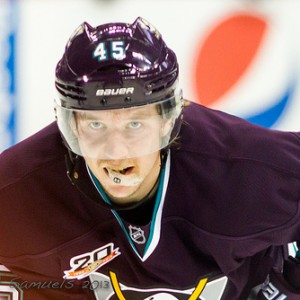
Individual Leaders
Goals: MN-13 Jared Spurgeon, ANA-10 Sami Vatanen, and Hampus Lindholm
Assists: MN-46 Ryan Suter, ANA- 32 Sami Vatanen
Points: MN-54 Ryan Suter, ANA-42 Sami Vatanen
Boudreau might be leaving a better forward group, but he will see improvements at the point. The Wild D-group is crushed in the underlying numbers department, but they were able to produce more goals and assists than the Ducks group. (Side note: it might seem odd to have assists, but I have it because I feel it indicates how well defensemen put forwards in position go score goals during the breakout or zone-entry.)
The Wild have a great D-core that will only get better. Dumba, Reilly, and Brodin are all still developing. Spurgeon and Suter are both great at what they do, and I expect Scandella to bounce back after a down year. This a group that will give Boudreau more to work with than he had in Anaheim.
ADVANTAGE- WILD 6-2 (TOTAL: 8-8)
Goaltending
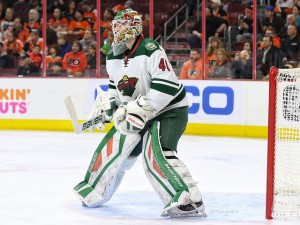
Avg. Sv%: MN-92.76, ANA-91.78
Top Sv%: MN-Dubnyk 93.29, ANA- Andersen 92.96
Another area in which the Wild come out on top is goaltending. This is the one area where it would be very difficult to argue against the Wild having the advantage. The goal total of the forwards and defensemen being similar could be linked back to the rough start for the Ducks, and the wide gap in underlying numbers would indicate that the Ducks players were simply better. That is not the case with goaltending. Kuemper and Dubnyk were better together than any goalies the Ducks rolled out, and Dubnyk was the best of the bunch.
ADVANTAGE- WILD 2-0 (TOTAL: 10-8 WILD)
Team
CF%: MN- 47.59, ANA-52.76
xGF%: MN-50.15, ANA-52.65
ADVANTAGE- DUCKS 2-0 (TOTAL: 10-10)
Anaheim takes the final two measurements by a wide margin. The Ducks were a team that had the puck more often, and in doing so were able to generate more quality shots. The good news for Wild fans? Boudreau has had that effect on every team he has coached. Wild players were able to produce well and were able to basically split xGF% without controlling play. If Boudreau again gets his team to control the play, then expect CF% and xGF% to go up for the team. This is good news, as both numbers have a strong correlation to wins.
ADVANTAGE- 10-10
Conclusion
The Wild of 2016-17 and Ducks of 2015-16 are not that different, though I’d have to give the edge to the Ducks due to their dominant underlying numbers. Saying that, of the twenty units of measurements used in my uber-scientific collection of data, the teams came out at an even split of 10-10. Boudreau will certainly miss having players like Getzlaf and Perry, but having a deep blue line and a solid goalie situation certainly makes up for the loss. Plus, beyond those two studs (who are past their primes) the Ducks do not have anything the Wild do not.
Boudreau has shown the ability to adjust to the roster that he has. That is the way he goes about coaching a team, and a huge reason he has had such great success. Based on his past performance as a head coach in the NHL, and the relative similarities between the Wild of 2016-17 and the Ducks of 2015-16, I expect immediate and impactful results. The Wild are a better team with Boudreau behind the bench. There will be no one to blame but the players (specifically Parise, Suter, and Koivu-the infamous leadership group) for not responding to a great coach. They are out of excuses, time to put it all together and find some consistency.